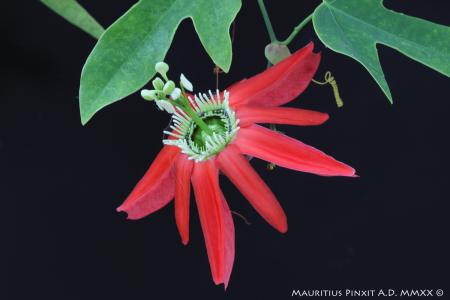
SUBGENUS: passiflora
SUPERSECTION: stipulata
SECTION: calopathanthus
GEOGRAPHICAL DISTRIBUTION OR ORIGIN:
Brazil (Rio De Janeiro Region).
MINIMUM TEMPERATURE: 8 °C
IDEAL MINIMUM TEMPERATURE: 12 °C
SYNONYMS: P. princeps Lodd.
ETYMOLOGY: From the Latin racemosus, done in cluster, characteristic of the inflorescences.
NOTES: Chromosomes: n=9, 2n=18
DESCRIPTION:
Propagation from cuttings is equally difficult, as this often produces stunted plants. It should be done in March or April to get better results, otherwise, one will need to resort to sowing.
Cultivation in pots is not very easy and one may suffer losses due to chlorosis, root fungi, or humidity stagnation. However, specimens consolidated in large pots become spectacular due to their incessant flowering.
Ripe fruits are yellow in colour and elongated ovoid in shape.
The racemes, which are directly joined to the older stems, can bear up to forty scarlet red flowers (about 10 cm in diameter). They open in succession from blood-red bracts. The sepals are hooked, the petals are narrow and elongated. The main corona has filaments that are white at the base and apex, red in the middle. The secondary ones offer contrast with their very dark red colour. There are forms with a white corona.
Its leaves (8 cm long x 11 cm wide) are slightly leathery, shiny and bright. Their shape varies: in young specimens, they are whole or at times bilobate, as if incomplete. Adult specimens always have three open lobes with a wavy, elegant profile. The form from the Brazilian town of Buzios has whole leaves.
Elsewhere it is preferable to place it in a sufficiently large greenhouse, where it will bloom from late spring until late autumn and, sometimes, even in winter.
It is hardy enough to be grown outdoors in western Liguria and southern Italy by placing it against a south-facing wall. The minimum tolerated winter temperature is in fact 7°C but it will withstand short drops down to 0°C.
The
peculiarity of producing terminal clusters of flowers is a rarity in gen. Passiflora. The Brazilian P. racemosa, which amplifies the beauty
of its scarlet flowers thanks to this characteristic, is an exception.
TIMELAPSE: